Gigabyte Z77-HD4 Review
by Ian Cutress on May 19, 2013 10:00 AM EST- Posted in
- Motherboards
- Gigabyte
- Z77
Rightmark Audio Analyzer 6.2.5
In part due to reader requests, we are pleased to include Rightmark Audio Analyzer results in our benchmark suite. The premise behind Rightmark:AA is to test the input and output of the audio system to determine noise levels, range, harmonic distortion, stereo crosstalk and so forth. Rightmark:AA should indicate how well the sound system is built and isolated from electrical interference (either internally or externally). For this test we connect the Line Out to the Line In using a short six inch 3.5mm to 3.5mm high-quality jack, turn the OS volume to 100%, and run the Rightmark default test suite at 48 kHz, 96 kHz and 192 kHz. We look specifically at the Dynamic Range of the audio codec used on board, as well as the Total Harmonic Distortion + Noise.
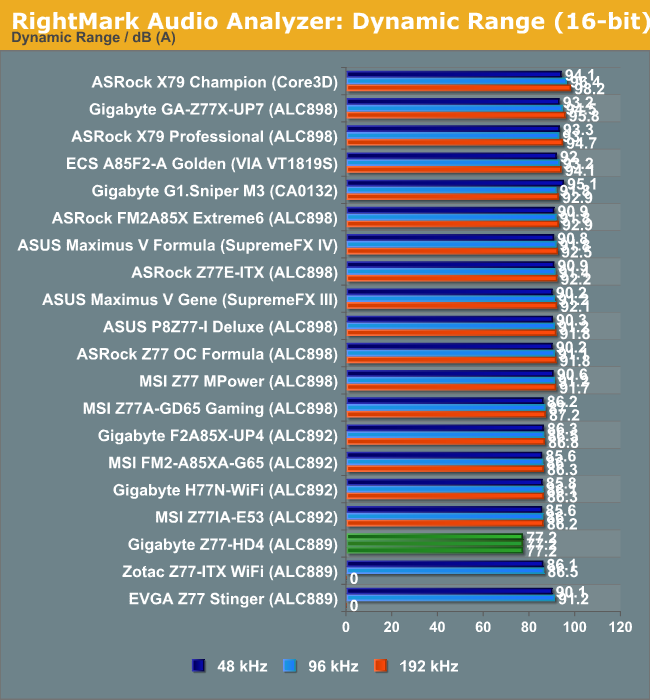
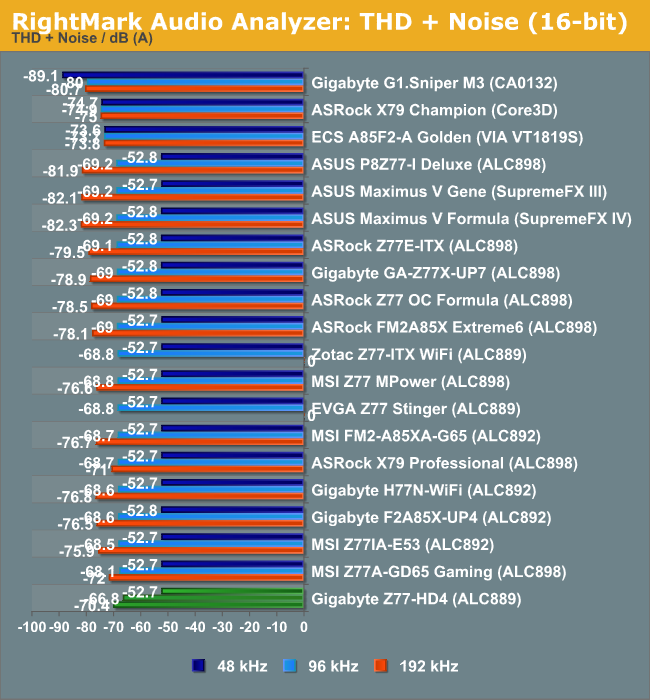
With the price of the board, we get one of the cheaper Realtek audio options. It performs worse in our testing than the ALC89x and above, but is able to pass our 192 kHz test unlike the ALC889 mITX versions.
USB 3.0 Backup
For this benchmark, we run CrystalDiskMark to determine the ideal sequential read and write speeds for the USB port using our 240 GB OCZ Vertex3 SSD with a SATA 6 Gbps to USB 3.0 converter. Then we transfer a set size of files from the SSD to the USB drive using DiskBench, which monitors the time taken to transfer. The files transferred are a 1.52 GB set of 2867 files across 320 folders – 95% of these files are small typical website files, and the rest (90% of the size) are the videos used in the WinRAR test.
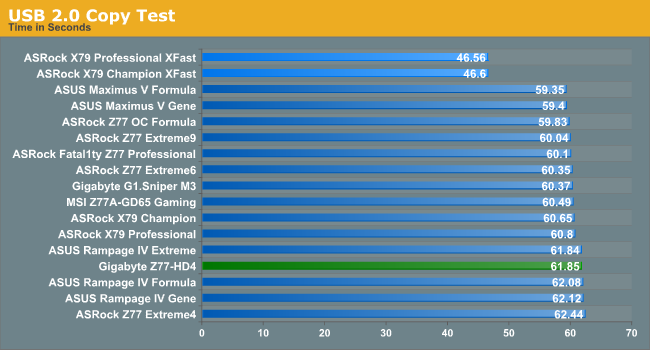
USB 2.0 performance is middling, on the wrong side of 61 seconds but only a fraction worse than the top non-XFast score.
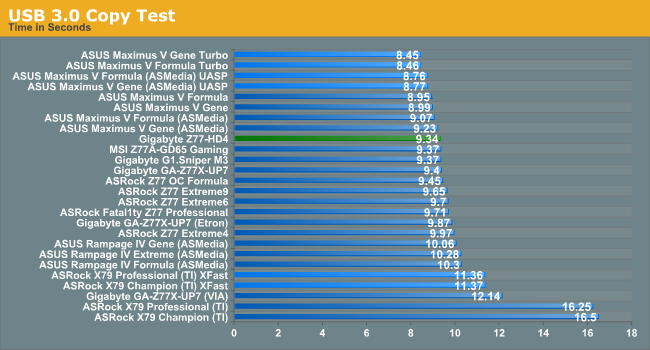
By contrast, the USB 3.0 performance is nearer the sharp end, despite sequential write speeds not being the best.
DPC Latency
Deferred Procedure Call latency is a way in which Windows handles interrupt servicing. In order to wait for a processor to acknowledge the request, the system will queue all interrupt requests by priority. Critical interrupts will be handled as soon as possible, whereas lesser priority requests, such as audio, will be further down the line. So if the audio device requires data, it will have to wait until the request is processed before the buffer is filled. If the device drivers of higher priority components in a system are poorly implemented, this can cause delays in request scheduling and process time, resulting in an empty audio buffer – this leads to characteristic audible pauses, pops and clicks. Having a bigger buffer and correctly implemented system drivers obviously helps in this regard. The DPC latency checker measures how much time is processing DPCs from driver invocation – the lower the value will result in better audio transfer at smaller buffer sizes. Results are measured in microseconds and taken as the peak latency while cycling through a series of short HD videos - under 500 microseconds usually gets the green light, but the lower the better.
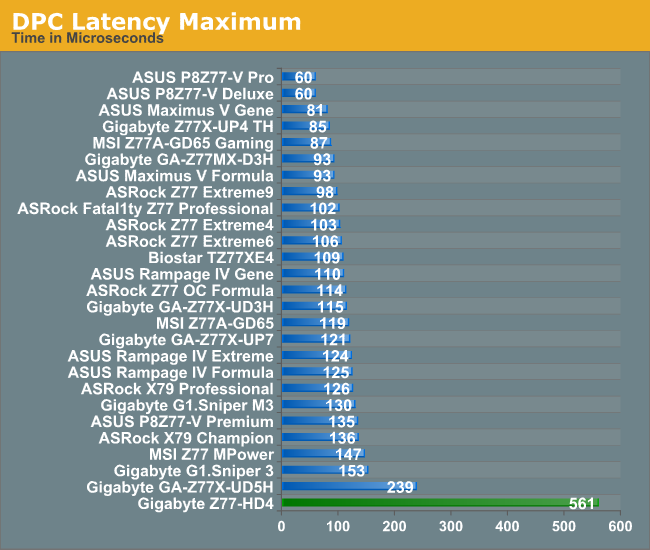
A major realisation of having that un-optimised BIOS is perhaps shown best in the DPC. To start, with the default install, the monitoring features of ET6 causes the DPC to peak at over 800 microseconds. Disabling this software causes a maximum of around 114 microseconds, although every so often we encountered a peak of around 300-500 microseconds, and 561 was recorded as the highest peak.










63 Comments
View All Comments
Grok42 - Monday, May 20, 2013 - link
I am extremely proud of the Anandtech readers that commented here. I typed out what would have been the first post on this review and at the last minute canceled it. I thought it too harsh and possibly wasn't fair to post it on a specific review when in fact it was about the editorial leaning of Anandtech as a whole.Go read the About page and you'll see this site is dedicated to reviewing computers, phones and components from consumer to enterprise. However, as of late it seems that all the reviews on the consumer side are completely bent toward some stereo-typical gamer building water cooled overclocked triple GPU gaming rigs. While nothing wrong with these types of builds and they are fun to read and think about, there has to be some respect for those that want other builds. I just spent $1500 building a mITX gaming and workstation rig with a core i7 3770. It has a $300 GPU, $300 CPU, $350 SSD, $120 case and a $80 MB running a stock Intel cooler. I couldn't be happier and NEVER intend to overclock it. As strange as my choices are, I bet I'm closer to 90% of the readership than a $600-$900 dual or triple GPU and $200 MB rig that seems to be implied as required equipment around here.
The worst of it is that there is a huge movement to smaller, cooler and quieter rigs that doesn't seem to have a voice on the inside at Anandtech. A full ATX tower running 3 GPUs and 5 HDDs is no longer the sought after box for a growing base of enthusiasts. The small cool looking mITX that can also play games is what's hot.
jabber - Monday, May 20, 2013 - link
Yes indeed, also quite a few of us here are over the age of 30 so a lot of the toys and whistles and flashing lights don't really appeal so much.We prefer durability, stability and value for money more.
I think a lot of the high-end manufacturers have forgotten that a lot of their consumer base has got a lot older. Buying boxes with dragons and wonderwomen on them doesn't have quite the appeal it might have 15 years ago.
Razorbak86 - Monday, May 20, 2013 - link
LOL. Age doesn't have a thing to do with it. Money often does though. Remember, this site is oriented towards enthusiasts first. So don't hate because others like more expensive components than you can afford.kmmatney - Monday, May 20, 2013 - link
It not about being able to afford the high end stuff - but why pay %100 more for maybe a 10% gain in performance. I like to see all the reviews - high and and low end, so this review was great. At the end of the day, the parts I buy will be whatever gives the best bang-for-buck, at the performance level (and noise level) I can accept. I don't hate the reviews of high end parts, but I want reviews like this to balance things out.Wall Street - Monday, May 20, 2013 - link
It isn't even for a 10% gain in performance. I, and a many users like me, are not going to use more than one SSD, aren't going to use more than one GPU, aren't going to use more than a couple of USB 3.0 ports (I don't own a single USB 3.0 device), won't overvolt/aggressively overclock and I even use the digital audio out on top of that (although the analog audio on this board is very disappointing).In that case, $120 boards like this are nearly identical in performance to one of the top end offerings. I think that, in thinking this is a low end offering, Ian misses where the sweat spot of the market is entirely. $120 motherboards are solidly midrange. You can get a low-end motherboard for less than $70 on Newegg. Compared to what Dell uses in its desktops, this board is feature packed!
jabber - Monday, May 20, 2013 - link
It does actually. When you get a bit older you find out.Enjoy your youth while you have it!
jabber - Monday, May 20, 2013 - link
Oh and the PC enthusiast market is slowly diminishing. Sites like this need to diversify to appeal to types that don't think the peak of a good day is spent running Prime95 on a new PC for 24 hours.Rob94hawk - Monday, May 20, 2013 - link
Anyone want to explain to me why they're still putting USB 2.0 and SATA 3Gb/s when everything's backwards compatible?lever_age - Monday, May 20, 2013 - link
Every SATA 6 Gb/s and USB 3.0 port is handled by the Z77 chipset on that board. Actually, all the SATA 3 Gb/s and USB 2.0 are as well.If you want more of the faster SATA and USB, you need to pay for extra 3rd-party controller chips, which increases board costs. It's a legitimate form of product differentiation to leave those out on the cheaper products. But supposedly 8-series chipsets with Haswell (or at least most of them?) will support six SATA 6 Gb/s and six USB 3.0 natively.
jabber - Monday, May 20, 2013 - link
I find USB3 still isn't quite a solid in terms of "it just works" like USB2 does. I think the USB3 chipsets still haven't got bedded down in the OS as solidly as USB2.Give it another year or two and it should be...I hope.